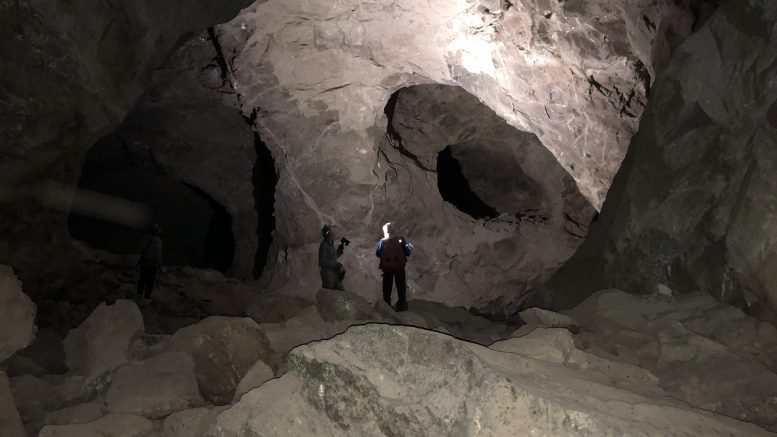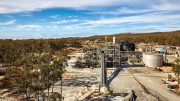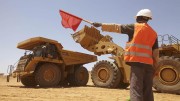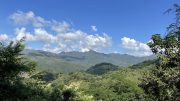Radius Gold (TSXV: RDU) has signed an option agreement to acquire a 100% interest in Plata Verde, a 3-sq.-km property north of its flagship Amalia gold-silver project in the state of Chihuahua, Mexico.
Plata Verde is located on the site of a historic and undocumented underground mining operation from the 1800s that Radius Gold discovered in January 2020. The project is east of the historic Batopilas silver mining district, which is reputed to have produced over 300 million oz. silver.
“We found the site after a Mexican geologist rang me up looking for a job,” Bruce Smith, Radius Gold’s exploration manager, said in telephone interview. “He was a little reluctant to tell me about it because he didn’t own it, but I agreed to include him in any negotiations if we decided to acquire the property.”

Plata Verde typical mineralization textures, crustiform banded barite calcite with silver chlorides, sulphosalt minerals and native silver infilling and cementing fractures and breccia. Note green silver chloride oxides after which the project was named. Photo credit: Simon Ridgway, Radius Gold.
Although the geologist wasn’t able to produce any geochemical or geophysical maps of the area, “there was something about the way he spoke and his experience and background that led me to think that it may be worth following up,” Smith said.
Smith then took a trip to Mexico to explore the area. After checking the Mexican Geological Survey and historical documents for the area, however, he could find no evidence of any mineralization or mining activities for the site.
“But after negotiating with the owners to gain access to the site, I was stunned to find evidence of an extensive and large scale underground bulk mining operation. We even found a couple of silver bars hidden within one of the old mines,” said Smith.
The company has now commenced detailed geological mapping and prospecting at the site and collected 110 rock chip samples, which returned silver grades of between five and 1,070 grams silver per tonne. Thirty-five of the samples were collected from the walls and the remaining pillars of the former mining operation returned values ranging from 5 grams to 849 grams silver per tonne, with an average of 276 grams silver per tonne. None of the samples returned gold mineralization, although all had trace amounts of copper, zinc and lead.
Roman numerals on walls throughout the historic mine signify up to 58 mining areas, and excavations define a strike extension of over 500 metres and up to 100 metres wide, with the host volcanic at least 60 metres thick.
Although Smith has been exploring for mineral deposits for over 20 years in North and Latin America, he hasn’t seen mineralization like it before. “It has unique geology, with silver chlorides and barite infilling basaltic andesite,” he said. “We’ve consulted with some of the most experienced geologists in the world, and they also say that they haven’t seen anything similar before either.”
The company now plans to map and undertake detailed sampling of all the known mineralized areas and excavation sites on the property. It also intends to conduct an airborne magnetic survey to help define the extensions of the host rocks.
Radius paid a local concession holder $8,000 on signing the deal and will pay staged payments of another $800,000 over four years, with a final payment of $400,000 at the end of the fourth year. The seller will then retain a 1% net smelter return royalty, which Radius Gold will be able to buy back for $1 million.

Silver bars (0.5 kg) found in mines at Plata Verde by a local worker in an old sack on the mine floor while taking samples for Radius. Photo credit: Alex Vaides, Radius Gold.
Meanwhile, work continues at the company’s flagship Amalia project.
In January, Radius Gold and its partner and project operator Pan American Silver (TSX: PAAS; NASDAQ: PAAS) reported results from the third phase of drilling.
Final assay results include intervals of 23 metres grading 4.61 grams gold per tonne and 41 grams silver per tonne; 1 metre of 12.5 grams gold and 2,320 grams silver; and 14 metres grading 1.39 grams gold and 22 grams silver.
In addition, Radius announced it has acquired an option to acquire the adjacent 8 sq. km Palmillas property, which hosts high-grade epithermal silver-gold mineralization that outcrops 1.8 km northwest along strike from Amalia.
Over the last year, Radius Gold has traded within a range of 10¢ and 47¢ per share and at press time was trading at 15¢. The junior explorer has 87 million common shares outstanding for a $13 million market capitalization.






Be the first to comment on "Radius Gold discovers historic silver mine in Mexico"